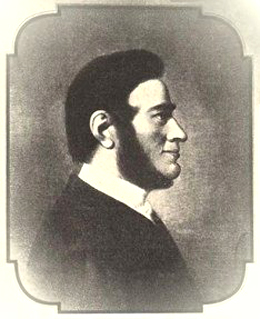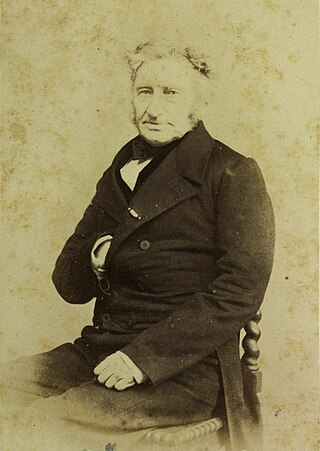
Carl Friedrich Philipp von Martius was a German botanist and explorer. Between 1817 and 1820, he travelled 10,000 km through Brazil while collecting botanical specimens. His most important work was a comprehensive flora of Brazil, Flora Brasiliensis, which he initiated in 1840 and was completed posthumously in 1906.

Carl Borivoj Presl was a Czech botanist.

Heinrich Gottlieb Ludwig Reichenbach was a German botanist, ornithologist and illustrator. It was he who first requested Leopold Blaschka to make a set of glass marine invertebrate models for scientific education and museum showcasing, the successful commission giving rise to the creation of the Blaschkas' Glass sea creatures and, subsequently and indirectly, the more famous Glass Flowers.
Johann Friedrich Klotzsch was a German pharmacist and botanist.

Elmer Drew Merrill was an American botanist and taxonomist. He spent more than twenty years in the Philippines where he became a recognized authority on the flora of the Asia-Pacific region. Through the course of his career he authored nearly 500 publications, described approximately 3,000 new plant species, and amassed over one million herbarium specimens. In addition to his scientific work he was an accomplished administrator, college dean, university professor and editor of scientific journals.
Karl Ludwig Philipp Zeyher, was a botanical and insect collector who collected extensively in Cape Colony. He was the author, with Christian Friedrich Ecklon, of Enumeratio Plantarum Africae Australis (1835-7), a descriptive catalogue of South African plants.
Christian Friedrich Ecklon was a Danish botanical collector and apothecary. Ecklon is especially known for being an avid collector and researcher of plants in South Africa.
Camillo Karl Schneider was a German botanist and landscape architect. A farmer's son, he was born at Gröppendorf, in the Kingdom of Saxony, and worked as a gardener at Zeitz, Dresden, Berlin and Greifswald. Returning to Berlin to work in the City Parks Department, he assisted in editorial work for the periodical Gartenwelt, which led to his employ as a landscape assistant in Darmstadt and Berlin. In 1900, he moved to Vienna, where he practiced as a freelance architect and writer, travelling extensively through Europe. In 1904 he published his first books, including the beginning of his tome Illustrated Handbook of Broad-leaved Trees, which he completed in 1912. However, the manuscript of what should have been his magnum opus, a study of the genus Berberis, was destroyed in a bombing raid on Berlin in 1943. In 1907 he created the specimen series Plantae hungaricae 1907 distributed as an exsiccata-like series.

Georg Hans Emmo Wolfgang Hieronymus (1846–1921) was a European botanist of German extraction. He was born in Silesia and died in Berlin.
Marie Clément Gaston Gautier was a French botanist and agriculturalist.

Marie-Anne Libert was a Belgian botanist and mycologist. She was one of the first women plant pathologists. She is sometimes referred to as "Anne-Marie Libert".
Boris Konstantinovich Schischkin was a Russian botanist and from 1943 corresponding member of the Academy of Sciences of the USSR. His name was Russian: Борис Константинович Шишкин, with his surname sometimes transliterated as Shishkin.
Ferdinand Paul Wirtgen was a German pharmacist and botanist. He was the son of botanist Philipp Wilhelm Wirtgen (1806–1870).
Heinrich Andres was a German educator and botanist known for his investigations of Rhineland flora.

Harald Lindberg was a Finnish botanist of Swedish parentage. He was the son of botanist Sextus Otto Lindberg (1835–1889).
Alexander Alfonsovich Grossheim was a Soviet botanist of German descent. He traveled widely over the Caucasus region collecting and studying various different plant life. He is most known for Pteridophytes and Spermatophytes species.
David Nathaniel Friedrich Dietrich was German botanist and gardener.
Georg August Zenker was a German gardener and naturalist.

Exsiccata is a work with "published, uniform, numbered set[s] of preserved specimens distributed with printed labels". Typically, exsiccatae refer to numbered collections of dried herbarium specimens or preserved biological samples published in several duplicate sets with a common theme or title, such as Lichenes Helvetici. Exsiccatae are regarded as scientific contributions of the editor(s) with characteristics from the library world and features from the herbarium world. Exsiccatae works represent a special method of scholarly communication. The text in the printed matters/published booklets is basically a list of labels (schedae) with information on each single numbered exsiccatal unit. Extensions of the concept occur.
IndExs – Index of Exsiccatae is an online biological database that plays a pivotal role in documenting more than 2,200 historical and ongoing series of exsiccatae and exsiccata-like works. Managed by the Botanische Staatssammlung München in München, IndExs serves as a comprehensive data repository for these series, providing detailed titles with information on the more than 1,300 editors, bibliographic information, exsiccatal numbers, publication timespans, ranges, information on preceding and superseding series and publishers. Exsiccatae, organised series of biological specimens distributed among biological collections, are essential resources found in major herbaria worldwide. Open access to the general information on exsiccatae facilitates global scientific engagement and research.








